Supply Chain Strategy & Processes of ZARA: A Critical Analysis
VerifiedAdded on 2023/06/18
|15
|4121
|471
AI Summary
This report discusses ZARA's supply chain strategy and processes, including its global supply chain, operations performance objectives, and comparison with its competitor. It also provides an overview of ZARA's product group and its flexibility strategy. The report critically analyzes ZARA's operations performance objective of flexibility and how it helps the company respond to changing market demands. The report also compares ZARA's operations performance objective with that of its competitor, H&M.
Contribute Materials
Your contribution can guide someone’s learning journey. Share your
documents today.
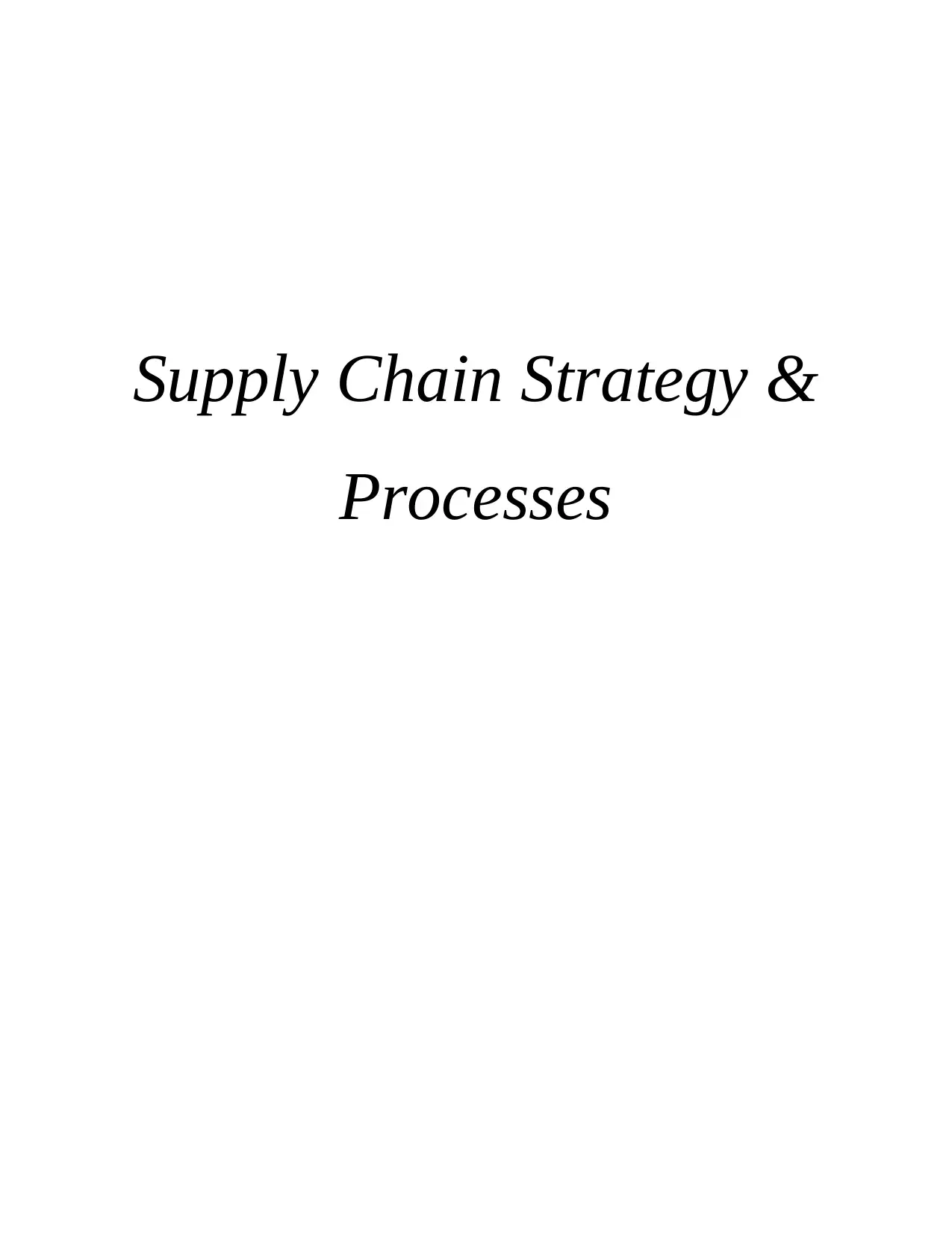
Supply Chain Strategy &
Processes
Processes
Secure Best Marks with AI Grader
Need help grading? Try our AI Grader for instant feedback on your assignments.
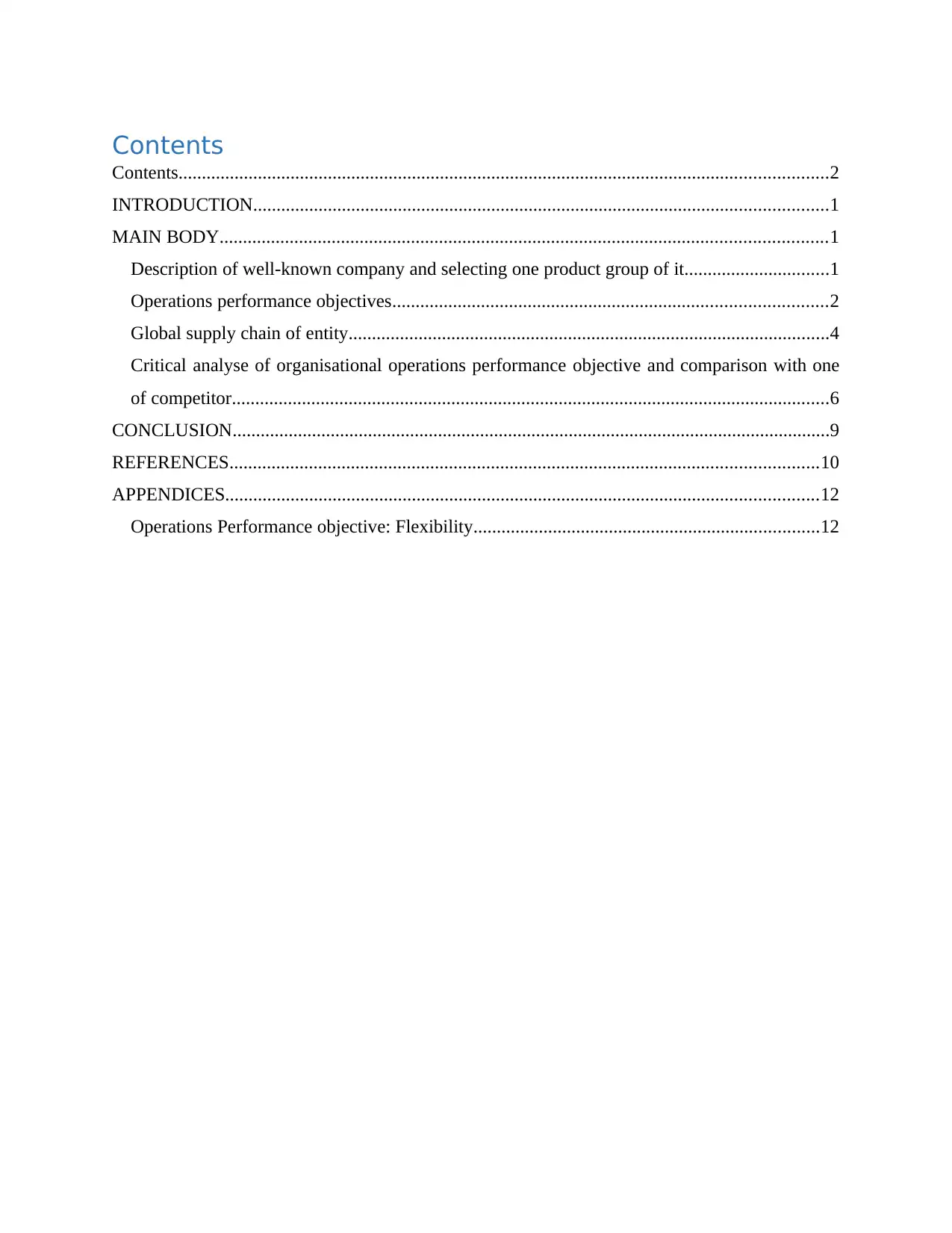
Contents
Contents...........................................................................................................................................2
INTRODUCTION...........................................................................................................................1
MAIN BODY..................................................................................................................................1
Description of well-known company and selecting one product group of it...............................1
Operations performance objectives.............................................................................................2
Global supply chain of entity.......................................................................................................4
Critical analyse of organisational operations performance objective and comparison with one
of competitor................................................................................................................................6
CONCLUSION................................................................................................................................9
REFERENCES..............................................................................................................................10
APPENDICES...............................................................................................................................12
Operations Performance objective: Flexibility..........................................................................12
Contents...........................................................................................................................................2
INTRODUCTION...........................................................................................................................1
MAIN BODY..................................................................................................................................1
Description of well-known company and selecting one product group of it...............................1
Operations performance objectives.............................................................................................2
Global supply chain of entity.......................................................................................................4
Critical analyse of organisational operations performance objective and comparison with one
of competitor................................................................................................................................6
CONCLUSION................................................................................................................................9
REFERENCES..............................................................................................................................10
APPENDICES...............................................................................................................................12
Operations Performance objective: Flexibility..........................................................................12

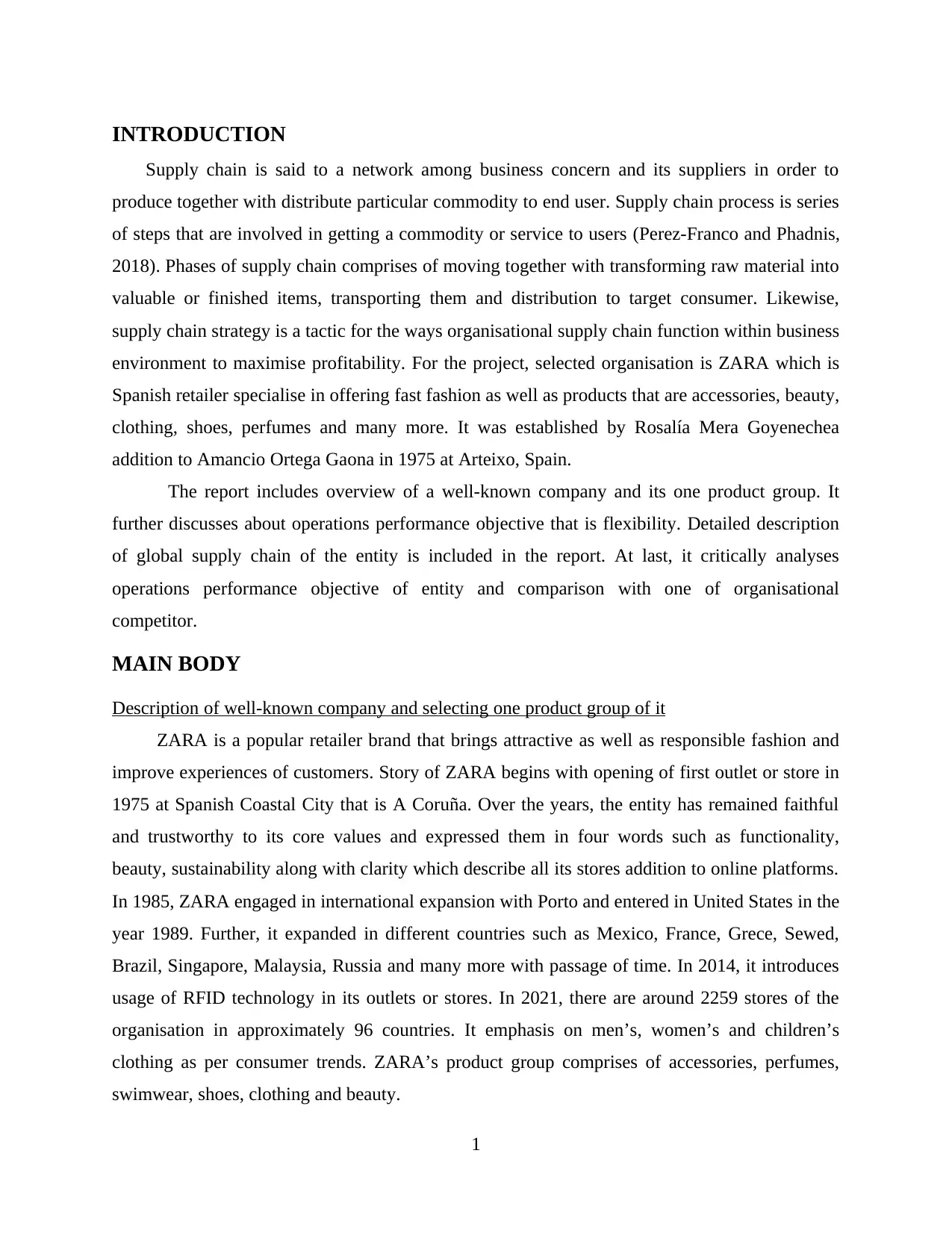
INTRODUCTION
Supply chain is said to a network among business concern and its suppliers in order to
produce together with distribute particular commodity to end user. Supply chain process is series
of steps that are involved in getting a commodity or service to users (Perez-Franco and Phadnis,
2018). Phases of supply chain comprises of moving together with transforming raw material into
valuable or finished items, transporting them and distribution to target consumer. Likewise,
supply chain strategy is a tactic for the ways organisational supply chain function within business
environment to maximise profitability. For the project, selected organisation is ZARA which is
Spanish retailer specialise in offering fast fashion as well as products that are accessories, beauty,
clothing, shoes, perfumes and many more. It was established by Rosalía Mera Goyenechea
addition to Amancio Ortega Gaona in 1975 at Arteixo, Spain.
The report includes overview of a well-known company and its one product group. It
further discusses about operations performance objective that is flexibility. Detailed description
of global supply chain of the entity is included in the report. At last, it critically analyses
operations performance objective of entity and comparison with one of organisational
competitor.
MAIN BODY
Description of well-known company and selecting one product group of it
ZARA is a popular retailer brand that brings attractive as well as responsible fashion and
improve experiences of customers. Story of ZARA begins with opening of first outlet or store in
1975 at Spanish Coastal City that is A Coruña. Over the years, the entity has remained faithful
and trustworthy to its core values and expressed them in four words such as functionality,
beauty, sustainability along with clarity which describe all its stores addition to online platforms.
In 1985, ZARA engaged in international expansion with Porto and entered in United States in the
year 1989. Further, it expanded in different countries such as Mexico, France, Grece, Sewed,
Brazil, Singapore, Malaysia, Russia and many more with passage of time. In 2014, it introduces
usage of RFID technology in its outlets or stores. In 2021, there are around 2259 stores of the
organisation in approximately 96 countries. It emphasis on men’s, women’s and children’s
clothing as per consumer trends. ZARA’s product group comprises of accessories, perfumes,
swimwear, shoes, clothing and beauty.
1
Supply chain is said to a network among business concern and its suppliers in order to
produce together with distribute particular commodity to end user. Supply chain process is series
of steps that are involved in getting a commodity or service to users (Perez-Franco and Phadnis,
2018). Phases of supply chain comprises of moving together with transforming raw material into
valuable or finished items, transporting them and distribution to target consumer. Likewise,
supply chain strategy is a tactic for the ways organisational supply chain function within business
environment to maximise profitability. For the project, selected organisation is ZARA which is
Spanish retailer specialise in offering fast fashion as well as products that are accessories, beauty,
clothing, shoes, perfumes and many more. It was established by Rosalía Mera Goyenechea
addition to Amancio Ortega Gaona in 1975 at Arteixo, Spain.
The report includes overview of a well-known company and its one product group. It
further discusses about operations performance objective that is flexibility. Detailed description
of global supply chain of the entity is included in the report. At last, it critically analyses
operations performance objective of entity and comparison with one of organisational
competitor.
MAIN BODY
Description of well-known company and selecting one product group of it
ZARA is a popular retailer brand that brings attractive as well as responsible fashion and
improve experiences of customers. Story of ZARA begins with opening of first outlet or store in
1975 at Spanish Coastal City that is A Coruña. Over the years, the entity has remained faithful
and trustworthy to its core values and expressed them in four words such as functionality,
beauty, sustainability along with clarity which describe all its stores addition to online platforms.
In 1985, ZARA engaged in international expansion with Porto and entered in United States in the
year 1989. Further, it expanded in different countries such as Mexico, France, Grece, Sewed,
Brazil, Singapore, Malaysia, Russia and many more with passage of time. In 2014, it introduces
usage of RFID technology in its outlets or stores. In 2021, there are around 2259 stores of the
organisation in approximately 96 countries. It emphasis on men’s, women’s and children’s
clothing as per consumer trends. ZARA’s product group comprises of accessories, perfumes,
swimwear, shoes, clothing and beauty.
1
Secure Best Marks with AI Grader
Need help grading? Try our AI Grader for instant feedback on your assignments.
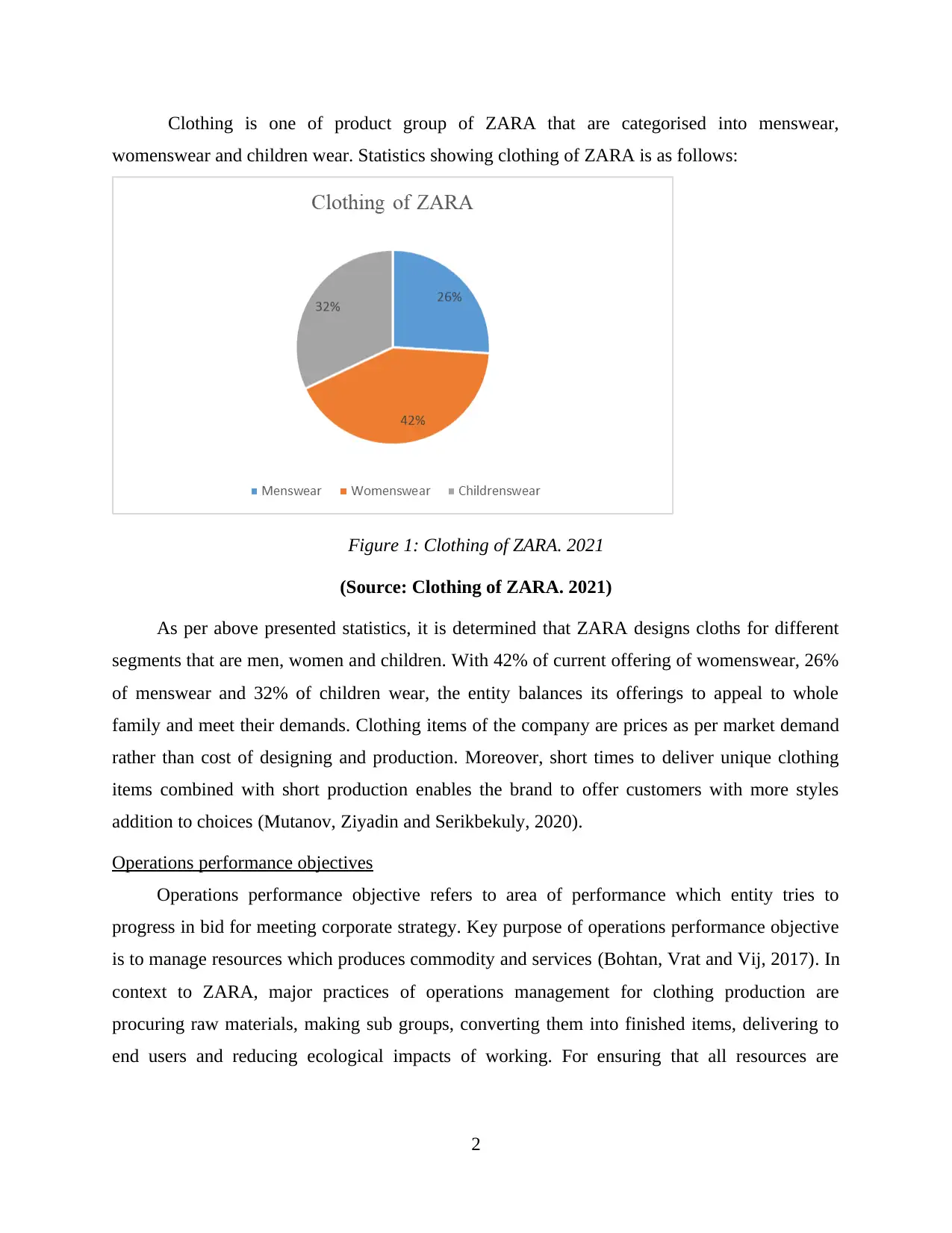
Clothing is one of product group of ZARA that are categorised into menswear,
womenswear and children wear. Statistics showing clothing of ZARA is as follows:
Figure 1: Clothing of ZARA. 2021
(Source: Clothing of ZARA. 2021)
As per above presented statistics, it is determined that ZARA designs cloths for different
segments that are men, women and children. With 42% of current offering of womenswear, 26%
of menswear and 32% of children wear, the entity balances its offerings to appeal to whole
family and meet their demands. Clothing items of the company are prices as per market demand
rather than cost of designing and production. Moreover, short times to deliver unique clothing
items combined with short production enables the brand to offer customers with more styles
addition to choices (Mutanov, Ziyadin and Serikbekuly, 2020).
Operations performance objectives
Operations performance objective refers to area of performance which entity tries to
progress in bid for meeting corporate strategy. Key purpose of operations performance objective
is to manage resources which produces commodity and services (Bohtan, Vrat and Vij, 2017). In
context to ZARA, major practices of operations management for clothing production are
procuring raw materials, making sub groups, converting them into finished items, delivering to
end users and reducing ecological impacts of working. For ensuring that all resources are
2
womenswear and children wear. Statistics showing clothing of ZARA is as follows:
Figure 1: Clothing of ZARA. 2021
(Source: Clothing of ZARA. 2021)
As per above presented statistics, it is determined that ZARA designs cloths for different
segments that are men, women and children. With 42% of current offering of womenswear, 26%
of menswear and 32% of children wear, the entity balances its offerings to appeal to whole
family and meet their demands. Clothing items of the company are prices as per market demand
rather than cost of designing and production. Moreover, short times to deliver unique clothing
items combined with short production enables the brand to offer customers with more styles
addition to choices (Mutanov, Ziyadin and Serikbekuly, 2020).
Operations performance objectives
Operations performance objective refers to area of performance which entity tries to
progress in bid for meeting corporate strategy. Key purpose of operations performance objective
is to manage resources which produces commodity and services (Bohtan, Vrat and Vij, 2017). In
context to ZARA, major practices of operations management for clothing production are
procuring raw materials, making sub groups, converting them into finished items, delivering to
end users and reducing ecological impacts of working. For ensuring that all resources are
2
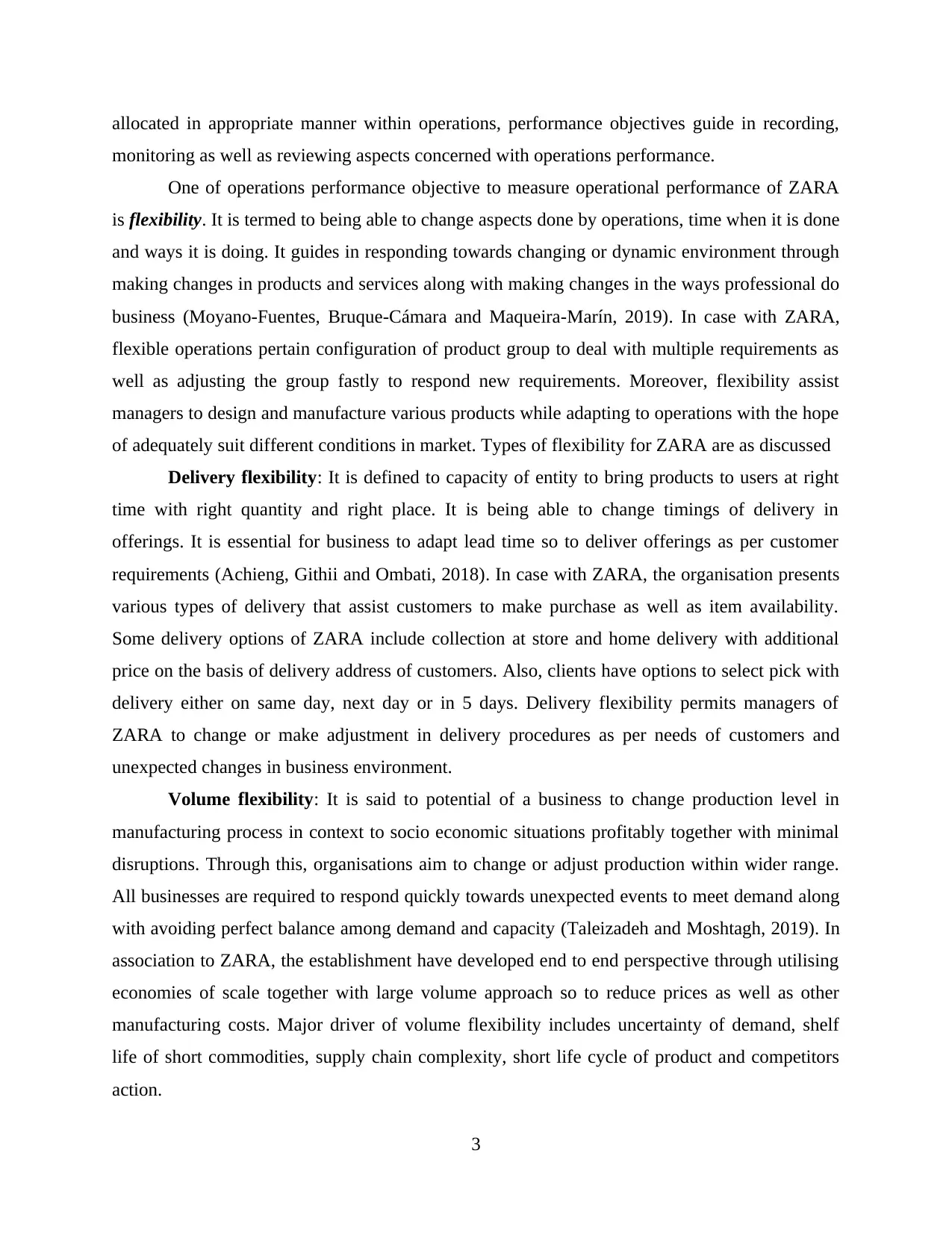
allocated in appropriate manner within operations, performance objectives guide in recording,
monitoring as well as reviewing aspects concerned with operations performance.
One of operations performance objective to measure operational performance of ZARA
is flexibility. It is termed to being able to change aspects done by operations, time when it is done
and ways it is doing. It guides in responding towards changing or dynamic environment through
making changes in products and services along with making changes in the ways professional do
business (Moyano-Fuentes, Bruque-Cámara and Maqueira-Marín, 2019). In case with ZARA,
flexible operations pertain configuration of product group to deal with multiple requirements as
well as adjusting the group fastly to respond new requirements. Moreover, flexibility assist
managers to design and manufacture various products while adapting to operations with the hope
of adequately suit different conditions in market. Types of flexibility for ZARA are as discussed
Delivery flexibility: It is defined to capacity of entity to bring products to users at right
time with right quantity and right place. It is being able to change timings of delivery in
offerings. It is essential for business to adapt lead time so to deliver offerings as per customer
requirements (Achieng, Githii and Ombati, 2018). In case with ZARA, the organisation presents
various types of delivery that assist customers to make purchase as well as item availability.
Some delivery options of ZARA include collection at store and home delivery with additional
price on the basis of delivery address of customers. Also, clients have options to select pick with
delivery either on same day, next day or in 5 days. Delivery flexibility permits managers of
ZARA to change or make adjustment in delivery procedures as per needs of customers and
unexpected changes in business environment.
Volume flexibility: It is said to potential of a business to change production level in
manufacturing process in context to socio economic situations profitably together with minimal
disruptions. Through this, organisations aim to change or adjust production within wider range.
All businesses are required to respond quickly towards unexpected events to meet demand along
with avoiding perfect balance among demand and capacity (Taleizadeh and Moshtagh, 2019). In
association to ZARA, the establishment have developed end to end perspective through utilising
economies of scale together with large volume approach so to reduce prices as well as other
manufacturing costs. Major driver of volume flexibility includes uncertainty of demand, shelf
life of short commodities, supply chain complexity, short life cycle of product and competitors
action.
3
monitoring as well as reviewing aspects concerned with operations performance.
One of operations performance objective to measure operational performance of ZARA
is flexibility. It is termed to being able to change aspects done by operations, time when it is done
and ways it is doing. It guides in responding towards changing or dynamic environment through
making changes in products and services along with making changes in the ways professional do
business (Moyano-Fuentes, Bruque-Cámara and Maqueira-Marín, 2019). In case with ZARA,
flexible operations pertain configuration of product group to deal with multiple requirements as
well as adjusting the group fastly to respond new requirements. Moreover, flexibility assist
managers to design and manufacture various products while adapting to operations with the hope
of adequately suit different conditions in market. Types of flexibility for ZARA are as discussed
Delivery flexibility: It is defined to capacity of entity to bring products to users at right
time with right quantity and right place. It is being able to change timings of delivery in
offerings. It is essential for business to adapt lead time so to deliver offerings as per customer
requirements (Achieng, Githii and Ombati, 2018). In case with ZARA, the organisation presents
various types of delivery that assist customers to make purchase as well as item availability.
Some delivery options of ZARA include collection at store and home delivery with additional
price on the basis of delivery address of customers. Also, clients have options to select pick with
delivery either on same day, next day or in 5 days. Delivery flexibility permits managers of
ZARA to change or make adjustment in delivery procedures as per needs of customers and
unexpected changes in business environment.
Volume flexibility: It is said to potential of a business to change production level in
manufacturing process in context to socio economic situations profitably together with minimal
disruptions. Through this, organisations aim to change or adjust production within wider range.
All businesses are required to respond quickly towards unexpected events to meet demand along
with avoiding perfect balance among demand and capacity (Taleizadeh and Moshtagh, 2019). In
association to ZARA, the establishment have developed end to end perspective through utilising
economies of scale together with large volume approach so to reduce prices as well as other
manufacturing costs. Major driver of volume flexibility includes uncertainty of demand, shelf
life of short commodities, supply chain complexity, short life cycle of product and competitors
action.
3
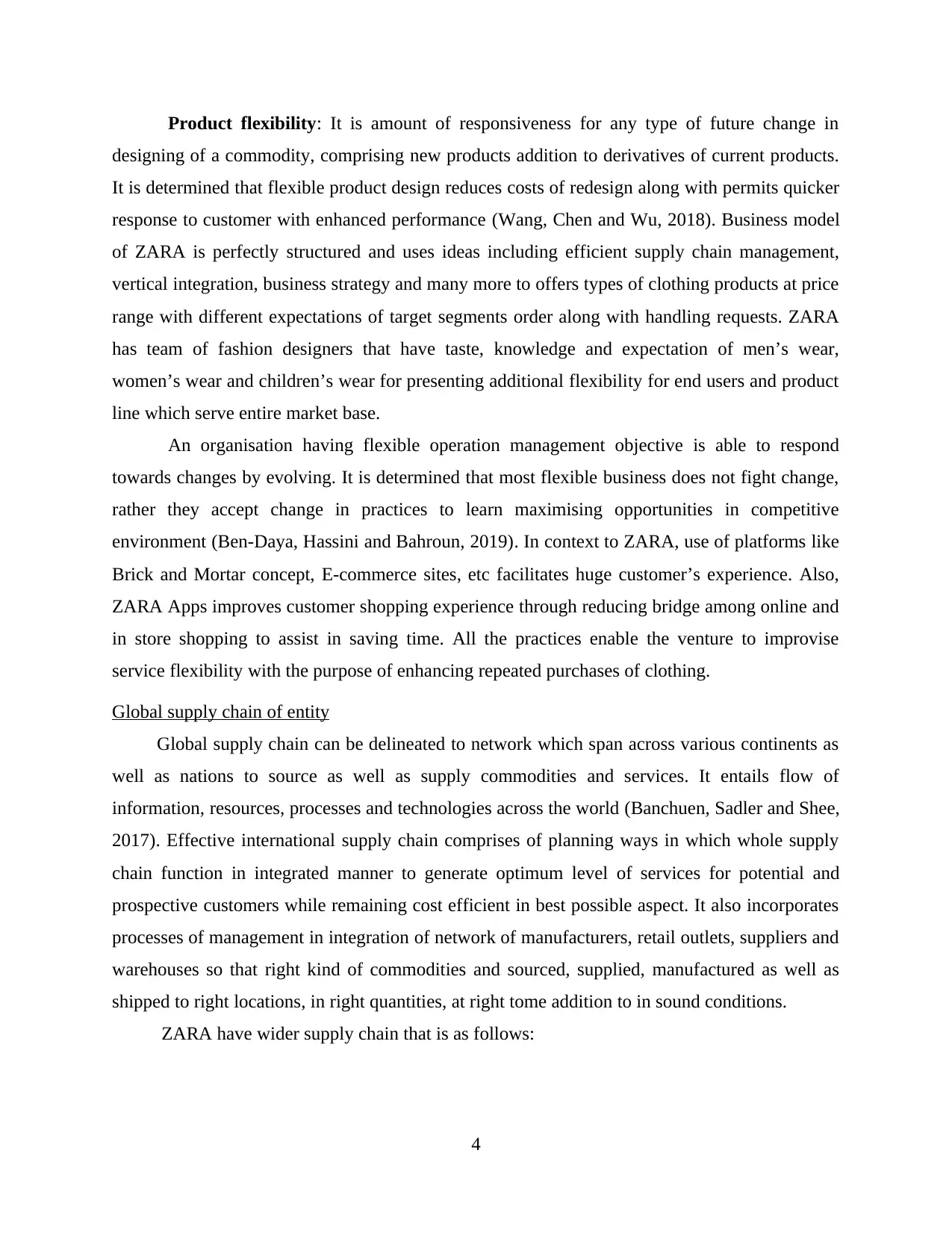
Product flexibility: It is amount of responsiveness for any type of future change in
designing of a commodity, comprising new products addition to derivatives of current products.
It is determined that flexible product design reduces costs of redesign along with permits quicker
response to customer with enhanced performance (Wang, Chen and Wu, 2018). Business model
of ZARA is perfectly structured and uses ideas including efficient supply chain management,
vertical integration, business strategy and many more to offers types of clothing products at price
range with different expectations of target segments order along with handling requests. ZARA
has team of fashion designers that have taste, knowledge and expectation of men’s wear,
women’s wear and children’s wear for presenting additional flexibility for end users and product
line which serve entire market base.
An organisation having flexible operation management objective is able to respond
towards changes by evolving. It is determined that most flexible business does not fight change,
rather they accept change in practices to learn maximising opportunities in competitive
environment (Ben-Daya, Hassini and Bahroun, 2019). In context to ZARA, use of platforms like
Brick and Mortar concept, E-commerce sites, etc facilitates huge customer’s experience. Also,
ZARA Apps improves customer shopping experience through reducing bridge among online and
in store shopping to assist in saving time. All the practices enable the venture to improvise
service flexibility with the purpose of enhancing repeated purchases of clothing.
Global supply chain of entity
Global supply chain can be delineated to network which span across various continents as
well as nations to source as well as supply commodities and services. It entails flow of
information, resources, processes and technologies across the world (Banchuen, Sadler and Shee,
2017). Effective international supply chain comprises of planning ways in which whole supply
chain function in integrated manner to generate optimum level of services for potential and
prospective customers while remaining cost efficient in best possible aspect. It also incorporates
processes of management in integration of network of manufacturers, retail outlets, suppliers and
warehouses so that right kind of commodities and sourced, supplied, manufactured as well as
shipped to right locations, in right quantities, at right tome addition to in sound conditions.
ZARA have wider supply chain that is as follows:
4
designing of a commodity, comprising new products addition to derivatives of current products.
It is determined that flexible product design reduces costs of redesign along with permits quicker
response to customer with enhanced performance (Wang, Chen and Wu, 2018). Business model
of ZARA is perfectly structured and uses ideas including efficient supply chain management,
vertical integration, business strategy and many more to offers types of clothing products at price
range with different expectations of target segments order along with handling requests. ZARA
has team of fashion designers that have taste, knowledge and expectation of men’s wear,
women’s wear and children’s wear for presenting additional flexibility for end users and product
line which serve entire market base.
An organisation having flexible operation management objective is able to respond
towards changes by evolving. It is determined that most flexible business does not fight change,
rather they accept change in practices to learn maximising opportunities in competitive
environment (Ben-Daya, Hassini and Bahroun, 2019). In context to ZARA, use of platforms like
Brick and Mortar concept, E-commerce sites, etc facilitates huge customer’s experience. Also,
ZARA Apps improves customer shopping experience through reducing bridge among online and
in store shopping to assist in saving time. All the practices enable the venture to improvise
service flexibility with the purpose of enhancing repeated purchases of clothing.
Global supply chain of entity
Global supply chain can be delineated to network which span across various continents as
well as nations to source as well as supply commodities and services. It entails flow of
information, resources, processes and technologies across the world (Banchuen, Sadler and Shee,
2017). Effective international supply chain comprises of planning ways in which whole supply
chain function in integrated manner to generate optimum level of services for potential and
prospective customers while remaining cost efficient in best possible aspect. It also incorporates
processes of management in integration of network of manufacturers, retail outlets, suppliers and
warehouses so that right kind of commodities and sourced, supplied, manufactured as well as
shipped to right locations, in right quantities, at right tome addition to in sound conditions.
ZARA have wider supply chain that is as follows:
4
Paraphrase This Document
Need a fresh take? Get an instant paraphrase of this document with our AI Paraphraser
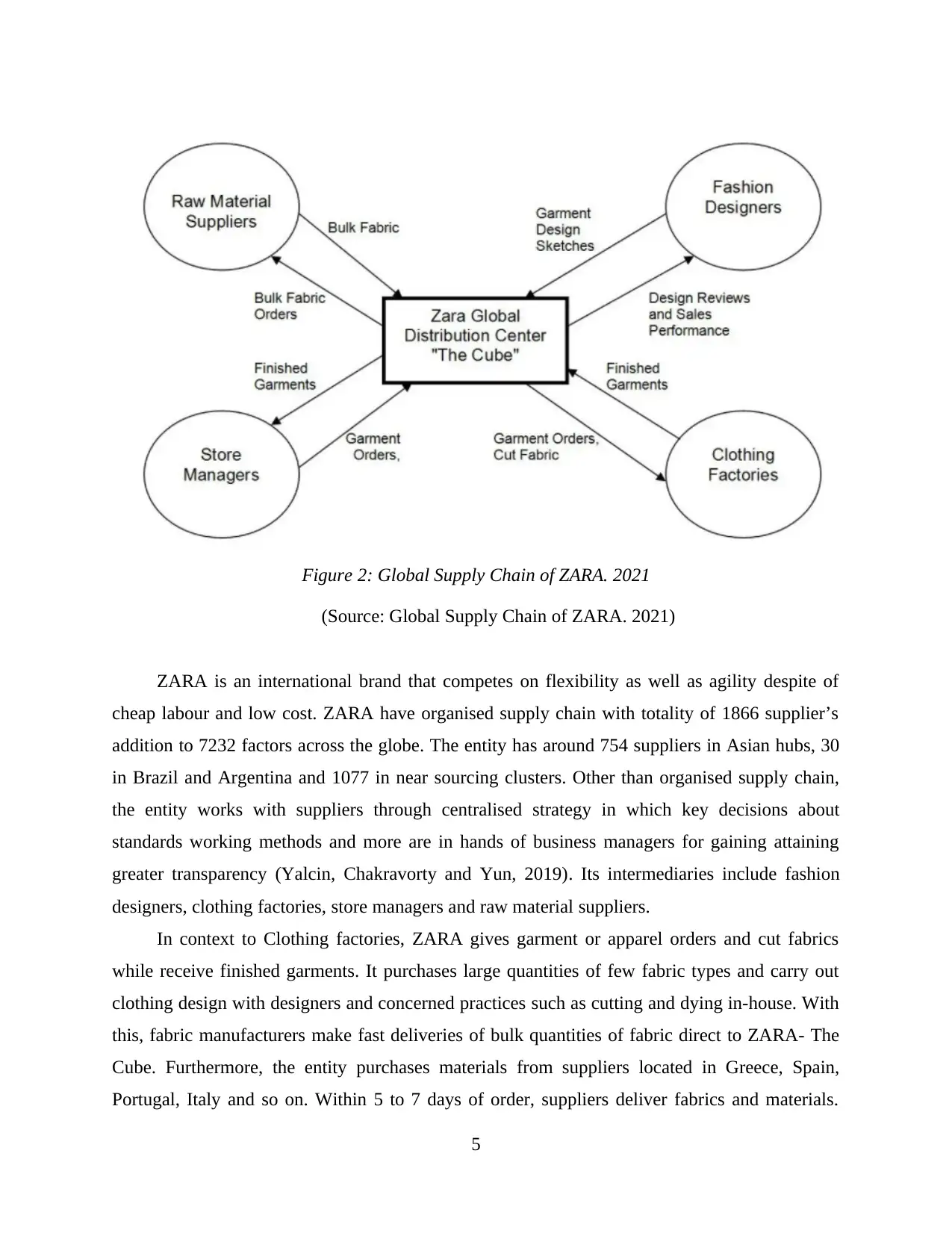
Figure 2: Global Supply Chain of ZARA. 2021
(Source: Global Supply Chain of ZARA. 2021)
ZARA is an international brand that competes on flexibility as well as agility despite of
cheap labour and low cost. ZARA have organised supply chain with totality of 1866 supplier’s
addition to 7232 factors across the globe. The entity has around 754 suppliers in Asian hubs, 30
in Brazil and Argentina and 1077 in near sourcing clusters. Other than organised supply chain,
the entity works with suppliers through centralised strategy in which key decisions about
standards working methods and more are in hands of business managers for gaining attaining
greater transparency (Yalcin, Chakravorty and Yun, 2019). Its intermediaries include fashion
designers, clothing factories, store managers and raw material suppliers.
In context to Clothing factories, ZARA gives garment or apparel orders and cut fabrics
while receive finished garments. It purchases large quantities of few fabric types and carry out
clothing design with designers and concerned practices such as cutting and dying in-house. With
this, fabric manufacturers make fast deliveries of bulk quantities of fabric direct to ZARA- The
Cube. Furthermore, the entity purchases materials from suppliers located in Greece, Spain,
Portugal, Italy and so on. Within 5 to 7 days of order, suppliers deliver fabrics and materials.
5
(Source: Global Supply Chain of ZARA. 2021)
ZARA is an international brand that competes on flexibility as well as agility despite of
cheap labour and low cost. ZARA have organised supply chain with totality of 1866 supplier’s
addition to 7232 factors across the globe. The entity has around 754 suppliers in Asian hubs, 30
in Brazil and Argentina and 1077 in near sourcing clusters. Other than organised supply chain,
the entity works with suppliers through centralised strategy in which key decisions about
standards working methods and more are in hands of business managers for gaining attaining
greater transparency (Yalcin, Chakravorty and Yun, 2019). Its intermediaries include fashion
designers, clothing factories, store managers and raw material suppliers.
In context to Clothing factories, ZARA gives garment or apparel orders and cut fabrics
while receive finished garments. It purchases large quantities of few fabric types and carry out
clothing design with designers and concerned practices such as cutting and dying in-house. With
this, fabric manufacturers make fast deliveries of bulk quantities of fabric direct to ZARA- The
Cube. Furthermore, the entity purchases materials from suppliers located in Greece, Spain,
Portugal, Italy and so on. Within 5 to 7 days of order, suppliers deliver fabrics and materials.
5
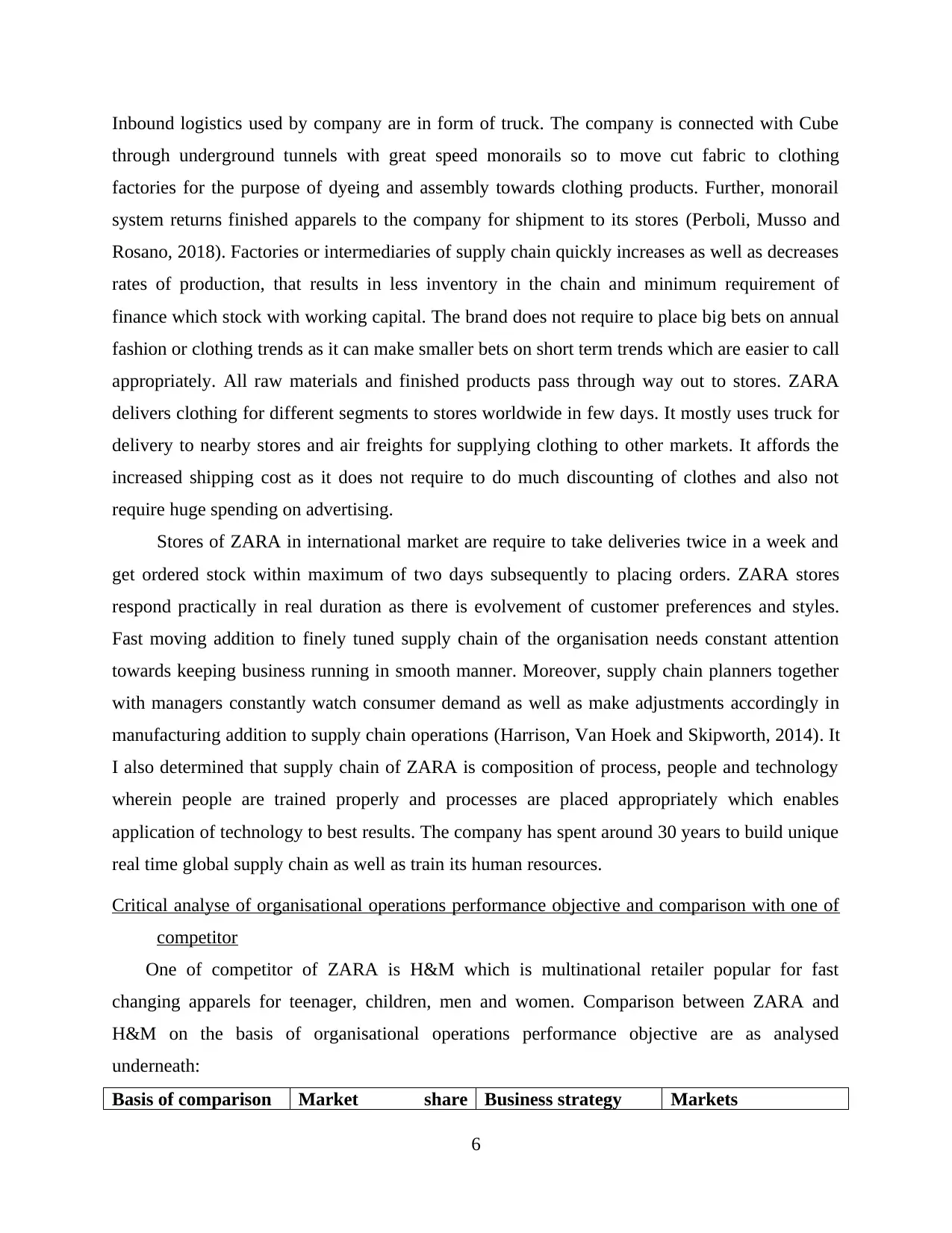
Inbound logistics used by company are in form of truck. The company is connected with Cube
through underground tunnels with great speed monorails so to move cut fabric to clothing
factories for the purpose of dyeing and assembly towards clothing products. Further, monorail
system returns finished apparels to the company for shipment to its stores (Perboli, Musso and
Rosano, 2018). Factories or intermediaries of supply chain quickly increases as well as decreases
rates of production, that results in less inventory in the chain and minimum requirement of
finance which stock with working capital. The brand does not require to place big bets on annual
fashion or clothing trends as it can make smaller bets on short term trends which are easier to call
appropriately. All raw materials and finished products pass through way out to stores. ZARA
delivers clothing for different segments to stores worldwide in few days. It mostly uses truck for
delivery to nearby stores and air freights for supplying clothing to other markets. It affords the
increased shipping cost as it does not require to do much discounting of clothes and also not
require huge spending on advertising.
Stores of ZARA in international market are require to take deliveries twice in a week and
get ordered stock within maximum of two days subsequently to placing orders. ZARA stores
respond practically in real duration as there is evolvement of customer preferences and styles.
Fast moving addition to finely tuned supply chain of the organisation needs constant attention
towards keeping business running in smooth manner. Moreover, supply chain planners together
with managers constantly watch consumer demand as well as make adjustments accordingly in
manufacturing addition to supply chain operations (Harrison, Van Hoek and Skipworth, 2014). It
I also determined that supply chain of ZARA is composition of process, people and technology
wherein people are trained properly and processes are placed appropriately which enables
application of technology to best results. The company has spent around 30 years to build unique
real time global supply chain as well as train its human resources.
Critical analyse of organisational operations performance objective and comparison with one of
competitor
One of competitor of ZARA is H&M which is multinational retailer popular for fast
changing apparels for teenager, children, men and women. Comparison between ZARA and
H&M on the basis of organisational operations performance objective are as analysed
underneath:
Basis of comparison Market share Business strategy Markets
6
through underground tunnels with great speed monorails so to move cut fabric to clothing
factories for the purpose of dyeing and assembly towards clothing products. Further, monorail
system returns finished apparels to the company for shipment to its stores (Perboli, Musso and
Rosano, 2018). Factories or intermediaries of supply chain quickly increases as well as decreases
rates of production, that results in less inventory in the chain and minimum requirement of
finance which stock with working capital. The brand does not require to place big bets on annual
fashion or clothing trends as it can make smaller bets on short term trends which are easier to call
appropriately. All raw materials and finished products pass through way out to stores. ZARA
delivers clothing for different segments to stores worldwide in few days. It mostly uses truck for
delivery to nearby stores and air freights for supplying clothing to other markets. It affords the
increased shipping cost as it does not require to do much discounting of clothes and also not
require huge spending on advertising.
Stores of ZARA in international market are require to take deliveries twice in a week and
get ordered stock within maximum of two days subsequently to placing orders. ZARA stores
respond practically in real duration as there is evolvement of customer preferences and styles.
Fast moving addition to finely tuned supply chain of the organisation needs constant attention
towards keeping business running in smooth manner. Moreover, supply chain planners together
with managers constantly watch consumer demand as well as make adjustments accordingly in
manufacturing addition to supply chain operations (Harrison, Van Hoek and Skipworth, 2014). It
I also determined that supply chain of ZARA is composition of process, people and technology
wherein people are trained properly and processes are placed appropriately which enables
application of technology to best results. The company has spent around 30 years to build unique
real time global supply chain as well as train its human resources.
Critical analyse of organisational operations performance objective and comparison with one of
competitor
One of competitor of ZARA is H&M which is multinational retailer popular for fast
changing apparels for teenager, children, men and women. Comparison between ZARA and
H&M on the basis of organisational operations performance objective are as analysed
underneath:
Basis of comparison Market share Business strategy Markets
6
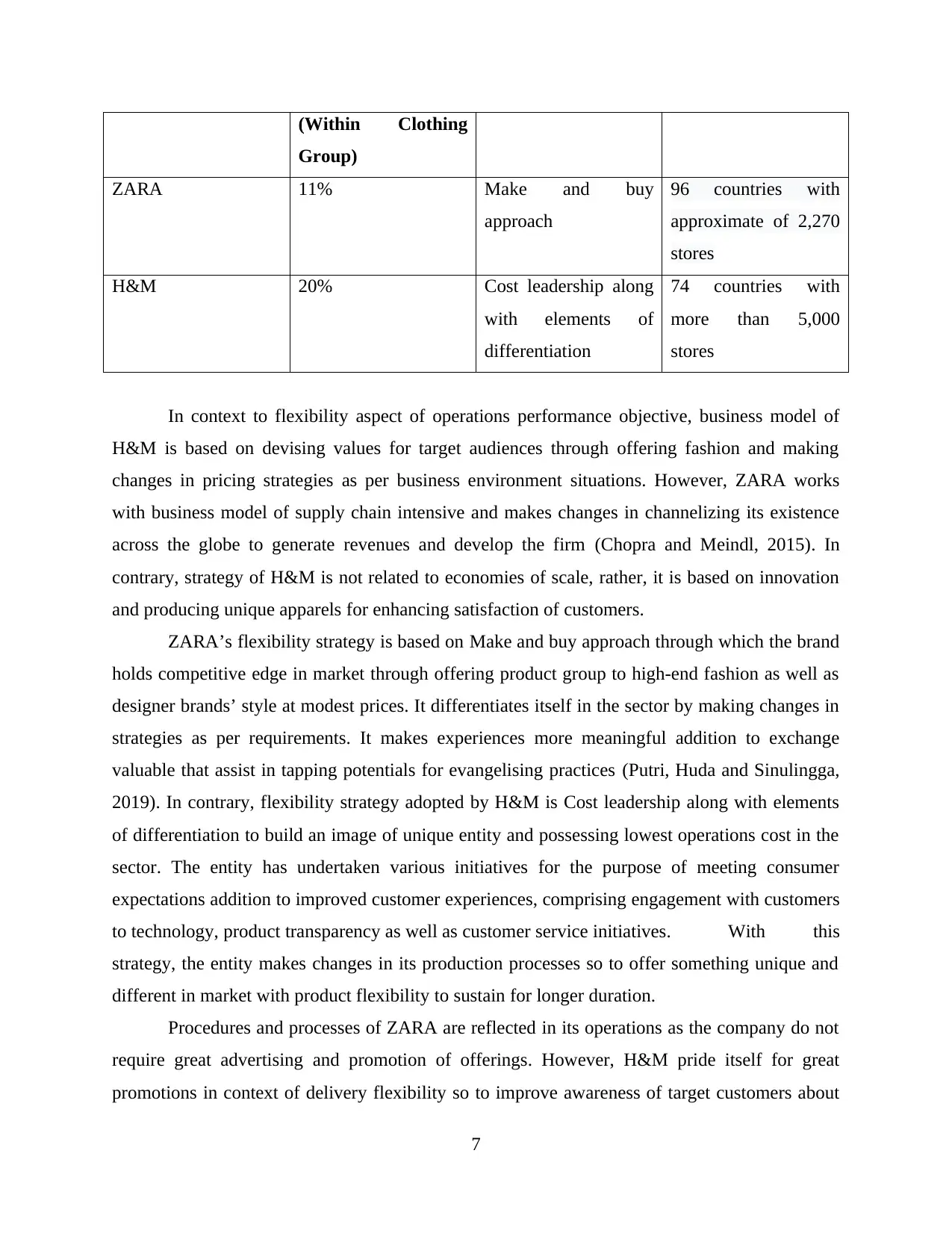
(Within Clothing
Group)
ZARA 11% Make and buy
approach
96 countries with
approximate of 2,270
stores
H&M 20% Cost leadership along
with elements of
differentiation
74 countries with
more than 5,000
stores
In context to flexibility aspect of operations performance objective, business model of
H&M is based on devising values for target audiences through offering fashion and making
changes in pricing strategies as per business environment situations. However, ZARA works
with business model of supply chain intensive and makes changes in channelizing its existence
across the globe to generate revenues and develop the firm (Chopra and Meindl, 2015). In
contrary, strategy of H&M is not related to economies of scale, rather, it is based on innovation
and producing unique apparels for enhancing satisfaction of customers.
ZARA’s flexibility strategy is based on Make and buy approach through which the brand
holds competitive edge in market through offering product group to high-end fashion as well as
designer brands’ style at modest prices. It differentiates itself in the sector by making changes in
strategies as per requirements. It makes experiences more meaningful addition to exchange
valuable that assist in tapping potentials for evangelising practices (Putri, Huda and Sinulingga,
2019). In contrary, flexibility strategy adopted by H&M is Cost leadership along with elements
of differentiation to build an image of unique entity and possessing lowest operations cost in the
sector. The entity has undertaken various initiatives for the purpose of meeting consumer
expectations addition to improved customer experiences, comprising engagement with customers
to technology, product transparency as well as customer service initiatives. With this
strategy, the entity makes changes in its production processes so to offer something unique and
different in market with product flexibility to sustain for longer duration.
Procedures and processes of ZARA are reflected in its operations as the company do not
require great advertising and promotion of offerings. However, H&M pride itself for great
promotions in context of delivery flexibility so to improve awareness of target customers about
7
Group)
ZARA 11% Make and buy
approach
96 countries with
approximate of 2,270
stores
H&M 20% Cost leadership along
with elements of
differentiation
74 countries with
more than 5,000
stores
In context to flexibility aspect of operations performance objective, business model of
H&M is based on devising values for target audiences through offering fashion and making
changes in pricing strategies as per business environment situations. However, ZARA works
with business model of supply chain intensive and makes changes in channelizing its existence
across the globe to generate revenues and develop the firm (Chopra and Meindl, 2015). In
contrary, strategy of H&M is not related to economies of scale, rather, it is based on innovation
and producing unique apparels for enhancing satisfaction of customers.
ZARA’s flexibility strategy is based on Make and buy approach through which the brand
holds competitive edge in market through offering product group to high-end fashion as well as
designer brands’ style at modest prices. It differentiates itself in the sector by making changes in
strategies as per requirements. It makes experiences more meaningful addition to exchange
valuable that assist in tapping potentials for evangelising practices (Putri, Huda and Sinulingga,
2019). In contrary, flexibility strategy adopted by H&M is Cost leadership along with elements
of differentiation to build an image of unique entity and possessing lowest operations cost in the
sector. The entity has undertaken various initiatives for the purpose of meeting consumer
expectations addition to improved customer experiences, comprising engagement with customers
to technology, product transparency as well as customer service initiatives. With this
strategy, the entity makes changes in its production processes so to offer something unique and
different in market with product flexibility to sustain for longer duration.
Procedures and processes of ZARA are reflected in its operations as the company do not
require great advertising and promotion of offerings. However, H&M pride itself for great
promotions in context of delivery flexibility so to improve awareness of target customers about
7
Secure Best Marks with AI Grader
Need help grading? Try our AI Grader for instant feedback on your assignments.
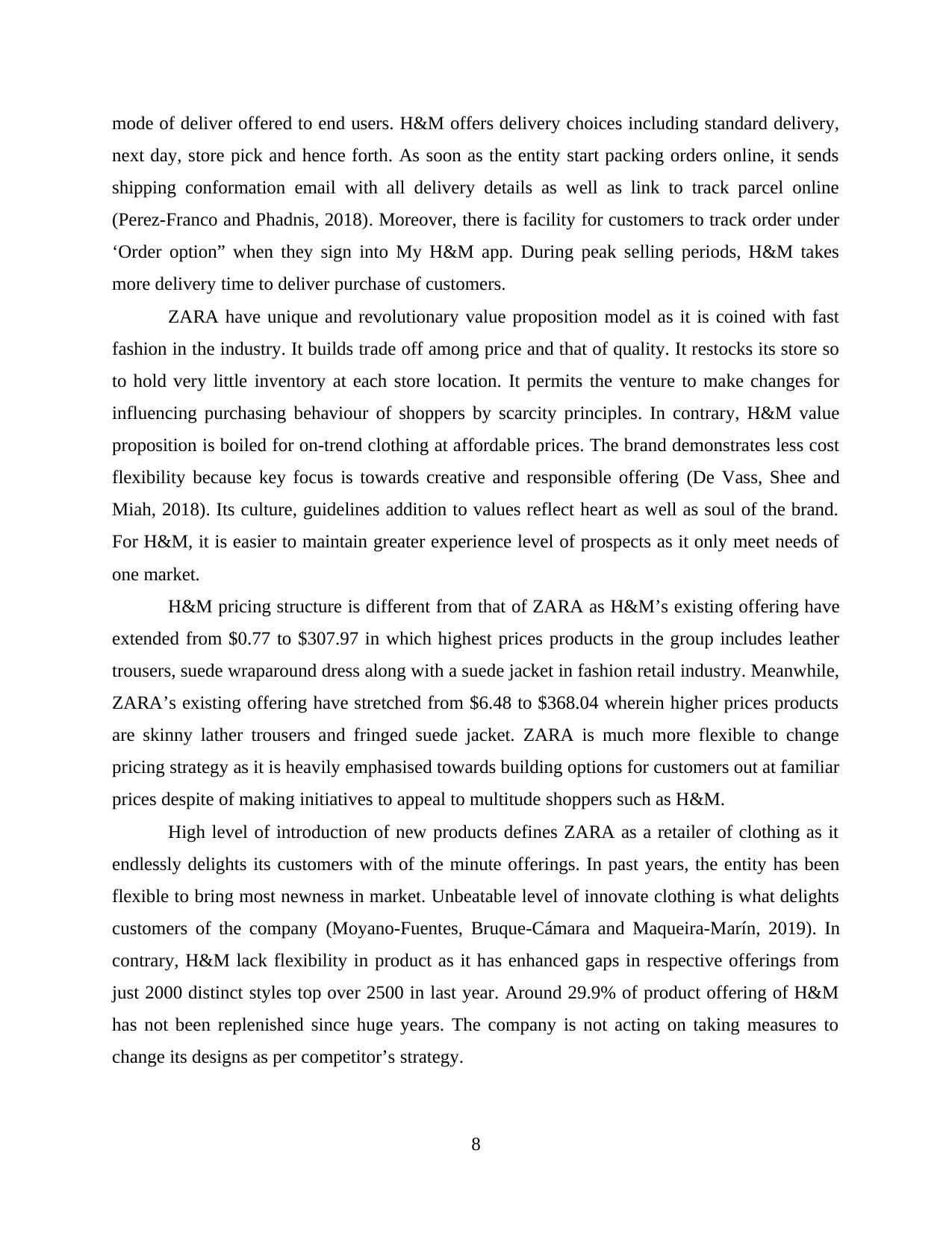
mode of deliver offered to end users. H&M offers delivery choices including standard delivery,
next day, store pick and hence forth. As soon as the entity start packing orders online, it sends
shipping conformation email with all delivery details as well as link to track parcel online
(Perez-Franco and Phadnis, 2018). Moreover, there is facility for customers to track order under
‘Order option” when they sign into My H&M app. During peak selling periods, H&M takes
more delivery time to deliver purchase of customers.
ZARA have unique and revolutionary value proposition model as it is coined with fast
fashion in the industry. It builds trade off among price and that of quality. It restocks its store so
to hold very little inventory at each store location. It permits the venture to make changes for
influencing purchasing behaviour of shoppers by scarcity principles. In contrary, H&M value
proposition is boiled for on-trend clothing at affordable prices. The brand demonstrates less cost
flexibility because key focus is towards creative and responsible offering (De Vass, Shee and
Miah, 2018). Its culture, guidelines addition to values reflect heart as well as soul of the brand.
For H&M, it is easier to maintain greater experience level of prospects as it only meet needs of
one market.
H&M pricing structure is different from that of ZARA as H&M’s existing offering have
extended from $0.77 to $307.97 in which highest prices products in the group includes leather
trousers, suede wraparound dress along with a suede jacket in fashion retail industry. Meanwhile,
ZARA’s existing offering have stretched from $6.48 to $368.04 wherein higher prices products
are skinny lather trousers and fringed suede jacket. ZARA is much more flexible to change
pricing strategy as it is heavily emphasised towards building options for customers out at familiar
prices despite of making initiatives to appeal to multitude shoppers such as H&M.
High level of introduction of new products defines ZARA as a retailer of clothing as it
endlessly delights its customers with of the minute offerings. In past years, the entity has been
flexible to bring most newness in market. Unbeatable level of innovate clothing is what delights
customers of the company (Moyano-Fuentes, Bruque-Cámara and Maqueira-Marín, 2019). In
contrary, H&M lack flexibility in product as it has enhanced gaps in respective offerings from
just 2000 distinct styles top over 2500 in last year. Around 29.9% of product offering of H&M
has not been replenished since huge years. The company is not acting on taking measures to
change its designs as per competitor’s strategy.
8
next day, store pick and hence forth. As soon as the entity start packing orders online, it sends
shipping conformation email with all delivery details as well as link to track parcel online
(Perez-Franco and Phadnis, 2018). Moreover, there is facility for customers to track order under
‘Order option” when they sign into My H&M app. During peak selling periods, H&M takes
more delivery time to deliver purchase of customers.
ZARA have unique and revolutionary value proposition model as it is coined with fast
fashion in the industry. It builds trade off among price and that of quality. It restocks its store so
to hold very little inventory at each store location. It permits the venture to make changes for
influencing purchasing behaviour of shoppers by scarcity principles. In contrary, H&M value
proposition is boiled for on-trend clothing at affordable prices. The brand demonstrates less cost
flexibility because key focus is towards creative and responsible offering (De Vass, Shee and
Miah, 2018). Its culture, guidelines addition to values reflect heart as well as soul of the brand.
For H&M, it is easier to maintain greater experience level of prospects as it only meet needs of
one market.
H&M pricing structure is different from that of ZARA as H&M’s existing offering have
extended from $0.77 to $307.97 in which highest prices products in the group includes leather
trousers, suede wraparound dress along with a suede jacket in fashion retail industry. Meanwhile,
ZARA’s existing offering have stretched from $6.48 to $368.04 wherein higher prices products
are skinny lather trousers and fringed suede jacket. ZARA is much more flexible to change
pricing strategy as it is heavily emphasised towards building options for customers out at familiar
prices despite of making initiatives to appeal to multitude shoppers such as H&M.
High level of introduction of new products defines ZARA as a retailer of clothing as it
endlessly delights its customers with of the minute offerings. In past years, the entity has been
flexible to bring most newness in market. Unbeatable level of innovate clothing is what delights
customers of the company (Moyano-Fuentes, Bruque-Cámara and Maqueira-Marín, 2019). In
contrary, H&M lack flexibility in product as it has enhanced gaps in respective offerings from
just 2000 distinct styles top over 2500 in last year. Around 29.9% of product offering of H&M
has not been replenished since huge years. The company is not acting on taking measures to
change its designs as per competitor’s strategy.
8
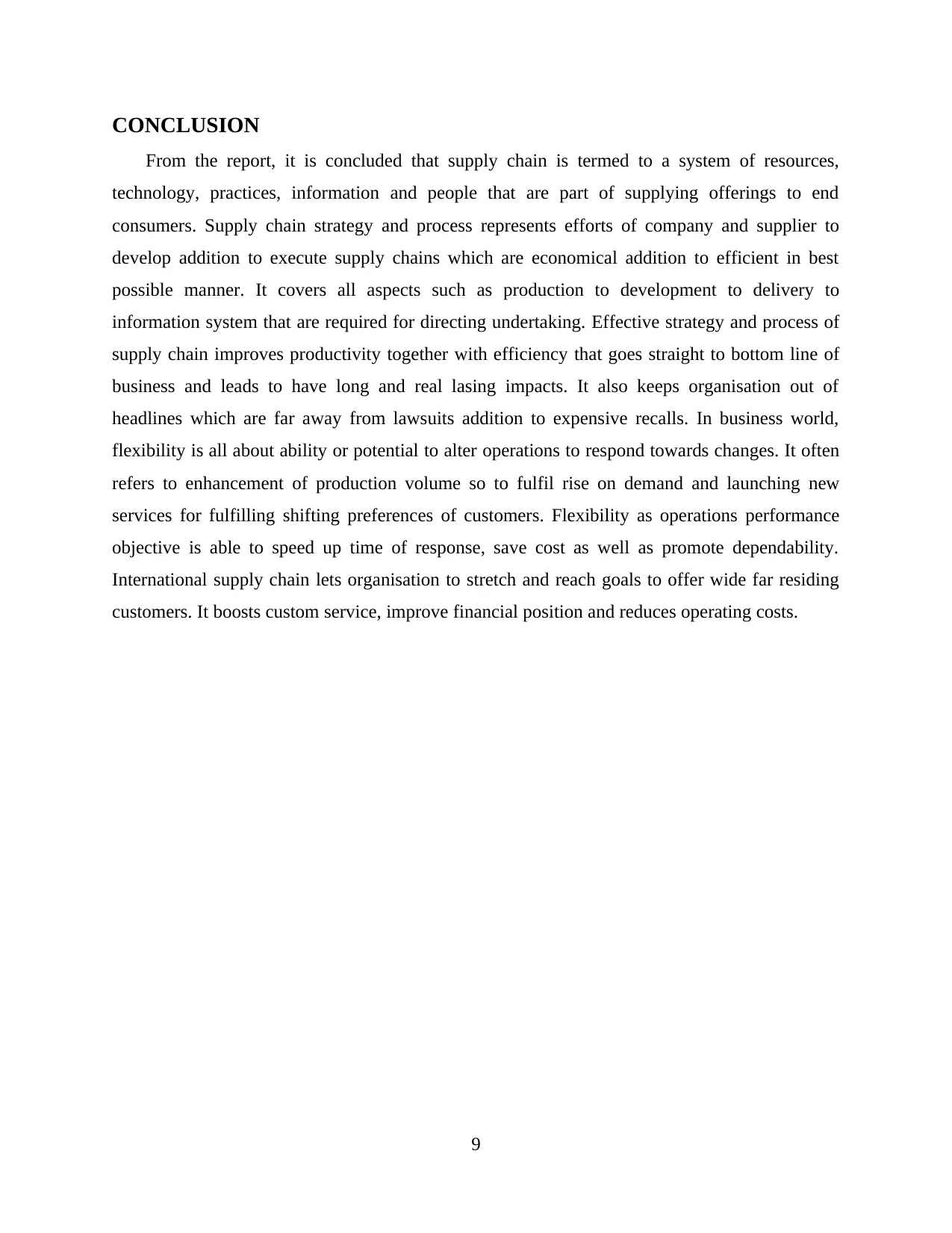
CONCLUSION
From the report, it is concluded that supply chain is termed to a system of resources,
technology, practices, information and people that are part of supplying offerings to end
consumers. Supply chain strategy and process represents efforts of company and supplier to
develop addition to execute supply chains which are economical addition to efficient in best
possible manner. It covers all aspects such as production to development to delivery to
information system that are required for directing undertaking. Effective strategy and process of
supply chain improves productivity together with efficiency that goes straight to bottom line of
business and leads to have long and real lasing impacts. It also keeps organisation out of
headlines which are far away from lawsuits addition to expensive recalls. In business world,
flexibility is all about ability or potential to alter operations to respond towards changes. It often
refers to enhancement of production volume so to fulfil rise on demand and launching new
services for fulfilling shifting preferences of customers. Flexibility as operations performance
objective is able to speed up time of response, save cost as well as promote dependability.
International supply chain lets organisation to stretch and reach goals to offer wide far residing
customers. It boosts custom service, improve financial position and reduces operating costs.
9
From the report, it is concluded that supply chain is termed to a system of resources,
technology, practices, information and people that are part of supplying offerings to end
consumers. Supply chain strategy and process represents efforts of company and supplier to
develop addition to execute supply chains which are economical addition to efficient in best
possible manner. It covers all aspects such as production to development to delivery to
information system that are required for directing undertaking. Effective strategy and process of
supply chain improves productivity together with efficiency that goes straight to bottom line of
business and leads to have long and real lasing impacts. It also keeps organisation out of
headlines which are far away from lawsuits addition to expensive recalls. In business world,
flexibility is all about ability or potential to alter operations to respond towards changes. It often
refers to enhancement of production volume so to fulfil rise on demand and launching new
services for fulfilling shifting preferences of customers. Flexibility as operations performance
objective is able to speed up time of response, save cost as well as promote dependability.
International supply chain lets organisation to stretch and reach goals to offer wide far residing
customers. It boosts custom service, improve financial position and reduces operating costs.
9
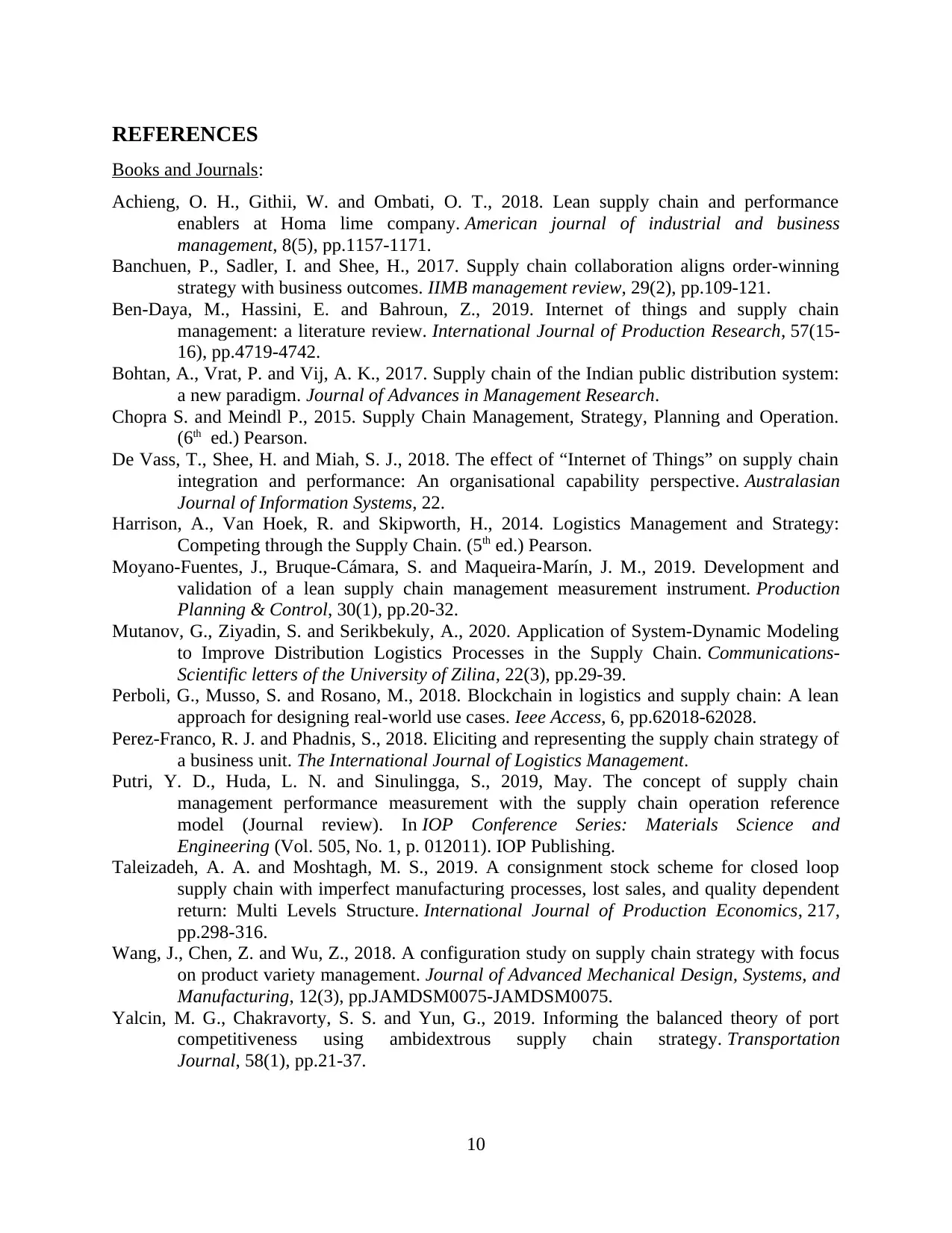
REFERENCES
Books and Journals:
Achieng, O. H., Githii, W. and Ombati, O. T., 2018. Lean supply chain and performance
enablers at Homa lime company. American journal of industrial and business
management, 8(5), pp.1157-1171.
Banchuen, P., Sadler, I. and Shee, H., 2017. Supply chain collaboration aligns order-winning
strategy with business outcomes. IIMB management review, 29(2), pp.109-121.
Ben-Daya, M., Hassini, E. and Bahroun, Z., 2019. Internet of things and supply chain
management: a literature review. International Journal of Production Research, 57(15-
16), pp.4719-4742.
Bohtan, A., Vrat, P. and Vij, A. K., 2017. Supply chain of the Indian public distribution system:
a new paradigm. Journal of Advances in Management Research.
Chopra S. and Meindl P., 2015. Supply Chain Management, Strategy, Planning and Operation.
(6th ed.) Pearson.
De Vass, T., Shee, H. and Miah, S. J., 2018. The effect of “Internet of Things” on supply chain
integration and performance: An organisational capability perspective. Australasian
Journal of Information Systems, 22.
Harrison, A., Van Hoek, R. and Skipworth, H., 2014. Logistics Management and Strategy:
Competing through the Supply Chain. (5th ed.) Pearson.
Moyano-Fuentes, J., Bruque-Cámara, S. and Maqueira-Marín, J. M., 2019. Development and
validation of a lean supply chain management measurement instrument. Production
Planning & Control, 30(1), pp.20-32.
Mutanov, G., Ziyadin, S. and Serikbekuly, A., 2020. Application of System-Dynamic Modeling
to Improve Distribution Logistics Processes in the Supply Chain. Communications-
Scientific letters of the University of Zilina, 22(3), pp.29-39.
Perboli, G., Musso, S. and Rosano, M., 2018. Blockchain in logistics and supply chain: A lean
approach for designing real-world use cases. Ieee Access, 6, pp.62018-62028.
Perez-Franco, R. J. and Phadnis, S., 2018. Eliciting and representing the supply chain strategy of
a business unit. The International Journal of Logistics Management.
Putri, Y. D., Huda, L. N. and Sinulingga, S., 2019, May. The concept of supply chain
management performance measurement with the supply chain operation reference
model (Journal review). In IOP Conference Series: Materials Science and
Engineering (Vol. 505, No. 1, p. 012011). IOP Publishing.
Taleizadeh, A. A. and Moshtagh, M. S., 2019. A consignment stock scheme for closed loop
supply chain with imperfect manufacturing processes, lost sales, and quality dependent
return: Multi Levels Structure. International Journal of Production Economics, 217,
pp.298-316.
Wang, J., Chen, Z. and Wu, Z., 2018. A configuration study on supply chain strategy with focus
on product variety management. Journal of Advanced Mechanical Design, Systems, and
Manufacturing, 12(3), pp.JAMDSM0075-JAMDSM0075.
Yalcin, M. G., Chakravorty, S. S. and Yun, G., 2019. Informing the balanced theory of port
competitiveness using ambidextrous supply chain strategy. Transportation
Journal, 58(1), pp.21-37.
10
Books and Journals:
Achieng, O. H., Githii, W. and Ombati, O. T., 2018. Lean supply chain and performance
enablers at Homa lime company. American journal of industrial and business
management, 8(5), pp.1157-1171.
Banchuen, P., Sadler, I. and Shee, H., 2017. Supply chain collaboration aligns order-winning
strategy with business outcomes. IIMB management review, 29(2), pp.109-121.
Ben-Daya, M., Hassini, E. and Bahroun, Z., 2019. Internet of things and supply chain
management: a literature review. International Journal of Production Research, 57(15-
16), pp.4719-4742.
Bohtan, A., Vrat, P. and Vij, A. K., 2017. Supply chain of the Indian public distribution system:
a new paradigm. Journal of Advances in Management Research.
Chopra S. and Meindl P., 2015. Supply Chain Management, Strategy, Planning and Operation.
(6th ed.) Pearson.
De Vass, T., Shee, H. and Miah, S. J., 2018. The effect of “Internet of Things” on supply chain
integration and performance: An organisational capability perspective. Australasian
Journal of Information Systems, 22.
Harrison, A., Van Hoek, R. and Skipworth, H., 2014. Logistics Management and Strategy:
Competing through the Supply Chain. (5th ed.) Pearson.
Moyano-Fuentes, J., Bruque-Cámara, S. and Maqueira-Marín, J. M., 2019. Development and
validation of a lean supply chain management measurement instrument. Production
Planning & Control, 30(1), pp.20-32.
Mutanov, G., Ziyadin, S. and Serikbekuly, A., 2020. Application of System-Dynamic Modeling
to Improve Distribution Logistics Processes in the Supply Chain. Communications-
Scientific letters of the University of Zilina, 22(3), pp.29-39.
Perboli, G., Musso, S. and Rosano, M., 2018. Blockchain in logistics and supply chain: A lean
approach for designing real-world use cases. Ieee Access, 6, pp.62018-62028.
Perez-Franco, R. J. and Phadnis, S., 2018. Eliciting and representing the supply chain strategy of
a business unit. The International Journal of Logistics Management.
Putri, Y. D., Huda, L. N. and Sinulingga, S., 2019, May. The concept of supply chain
management performance measurement with the supply chain operation reference
model (Journal review). In IOP Conference Series: Materials Science and
Engineering (Vol. 505, No. 1, p. 012011). IOP Publishing.
Taleizadeh, A. A. and Moshtagh, M. S., 2019. A consignment stock scheme for closed loop
supply chain with imperfect manufacturing processes, lost sales, and quality dependent
return: Multi Levels Structure. International Journal of Production Economics, 217,
pp.298-316.
Wang, J., Chen, Z. and Wu, Z., 2018. A configuration study on supply chain strategy with focus
on product variety management. Journal of Advanced Mechanical Design, Systems, and
Manufacturing, 12(3), pp.JAMDSM0075-JAMDSM0075.
Yalcin, M. G., Chakravorty, S. S. and Yun, G., 2019. Informing the balanced theory of port
competitiveness using ambidextrous supply chain strategy. Transportation
Journal, 58(1), pp.21-37.
10
Paraphrase This Document
Need a fresh take? Get an instant paraphrase of this document with our AI Paraphraser
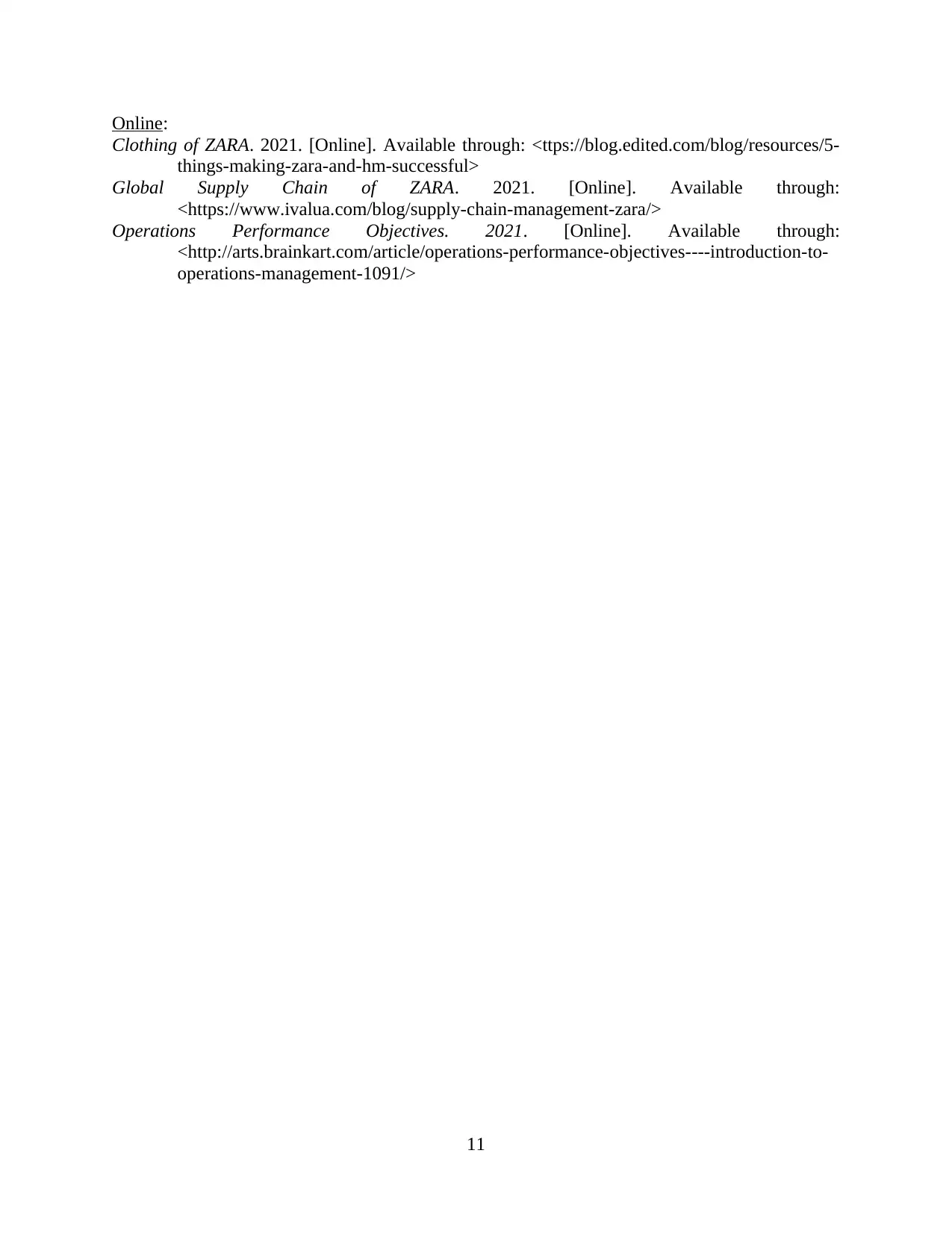
Online:
Clothing of ZARA. 2021. [Online]. Available through: <ttps://blog.edited.com/blog/resources/5-
things-making-zara-and-hm-successful>
Global Supply Chain of ZARA. 2021. [Online]. Available through:
<https://www.ivalua.com/blog/supply-chain-management-zara/>
Operations Performance Objectives. 2021. [Online]. Available through:
<http://arts.brainkart.com/article/operations-performance-objectives----introduction-to-
operations-management-1091/>
11
Clothing of ZARA. 2021. [Online]. Available through: <ttps://blog.edited.com/blog/resources/5-
things-making-zara-and-hm-successful>
Global Supply Chain of ZARA. 2021. [Online]. Available through:
<https://www.ivalua.com/blog/supply-chain-management-zara/>
Operations Performance Objectives. 2021. [Online]. Available through:
<http://arts.brainkart.com/article/operations-performance-objectives----introduction-to-
operations-management-1091/>
11
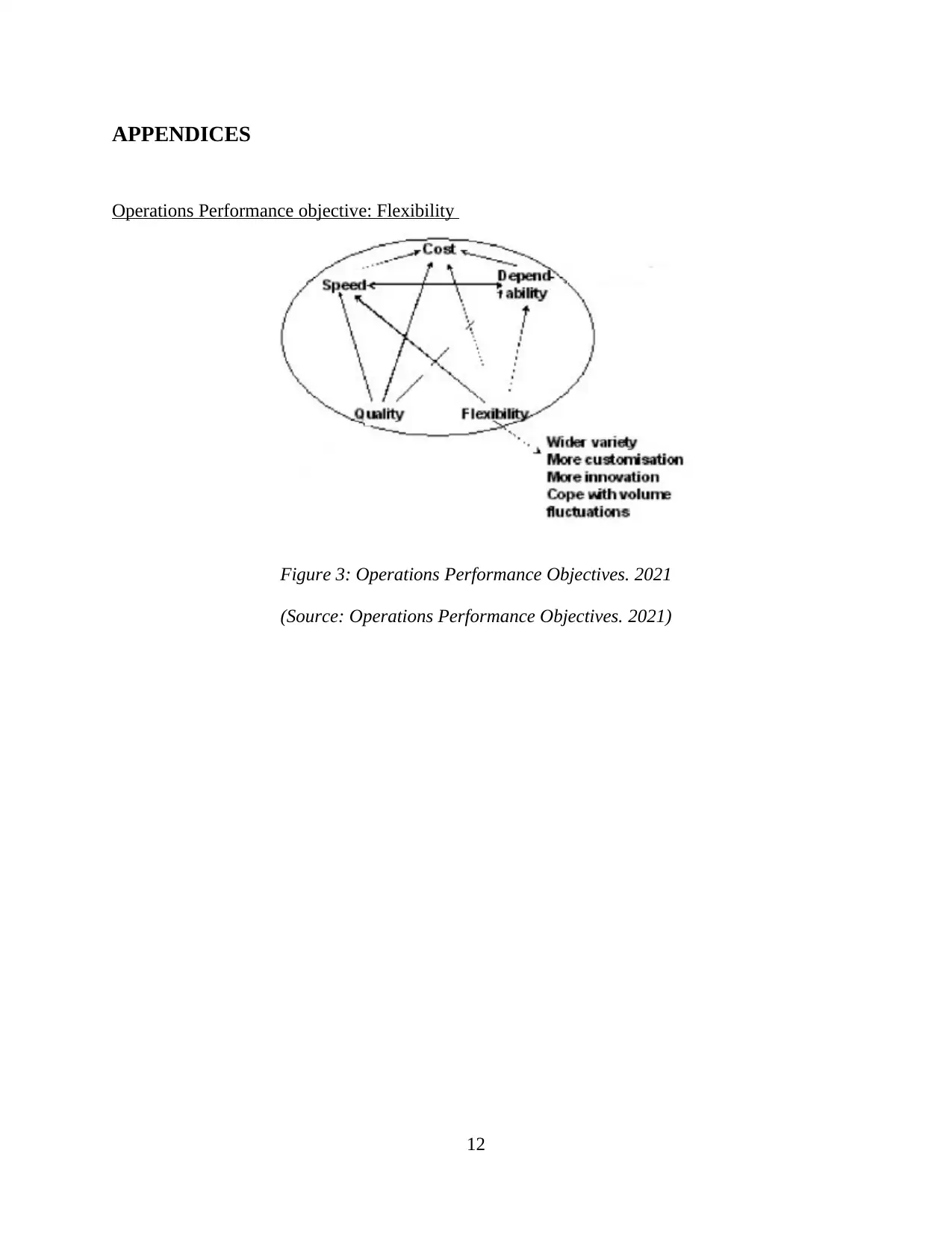
APPENDICES
Operations Performance objective: Flexibility
Figure 3: Operations Performance Objectives. 2021
(Source: Operations Performance Objectives. 2021)
12
Operations Performance objective: Flexibility
Figure 3: Operations Performance Objectives. 2021
(Source: Operations Performance Objectives. 2021)
12
1 out of 15
Related Documents
Your All-in-One AI-Powered Toolkit for Academic Success.
+13062052269
info@desklib.com
Available 24*7 on WhatsApp / Email
![[object Object]](/_next/static/media/star-bottom.7253800d.svg)
Unlock your academic potential
© 2024 | Zucol Services PVT LTD | All rights reserved.





